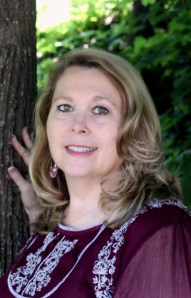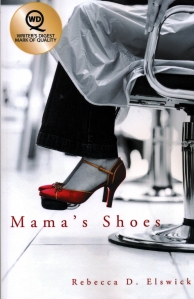I was recently interviewed by Appalachian author Bob Mustin. You can visit his blog "Gridey Fires" and read the interview at the above address. I have also copied it below. Thanks, Bob!
Coal Country and the Strength of Coal Women – An Interview with Rebecca Elswick
These interviews are with authors whose work shows great promise but still haven’t latched onto that larger audience. Hopefully these interviews will give the authors and their work a bit of a shove in the right direction. Rebecca Elswick, the subject of this interview, has had the earned fortune to have had a fine novel, Mama’s Shoes, published as a result of a Writer’s Digest contest. We think her insights into writing technique – as well as into her work itself – are certainly worth sharing here.

Gridley Fires: You’ve written a novel that spans quite a bit of time, including the World War II era. How did you decide to structure it as you did, moving back and forth in time, from the various characters’ points of view?
Rebecca Elswick: I wanted to begin the novel with Sassy’s point of view at an age when she would become aware that her mother was not like the other mothers in Coal Valley, so I decided to begin the story in the middle, after giving the reader a glimpse of Sylvia at age sixteen. This juxtaposed the world Sylvia anticipated at age sixteen with the world she ended up in at age thirty, leaving the reader to wonder – what happened?
GF: It seems you’ve given both Sylvia and Sassy equal time in this novel. Did you intend that, or do you consider one of them the primary character?
RE: Sylvia is the main character, but I wanted the story to be told from different points of view with the primary voice being her daughter, Sassy. I wanted to apply that old saying ‘there’s three sides to every story – mine, yours, and the truth.

GF: Madge is a character unlike others in your book. How did you come up with her? As you look at her now, did she serve her intended purpose(s)?
RE: I am the daughter of a beautician and much of my “beauty shop” story is based on my memories of the beauty shops where my mama worked. Like Sassy, I would empty the ashtrays and fold towels and do other jobs, and like Sassy, I would listen to the women talk. There always seemed to be a “Madge” beautician in these places. She was the one who didn’t care what she said or to whom she said it. I wanted to have a character like that who would champion Sylvia. Madge served as my message that family doesn’t always mean blood kin. Madge was as much Sylvia and Sassy’s family as Aunt Hat. I also wanted a character who was more “Appalachian” than the others in her speech, upbringing, and actions.
GF: Sassy’s friend Kitty and her family are clearly there for comparison to Sylvia and Sassy. How would you characterize this comparison?
RE: Kitty and her family were important for two reasons: they were the key to Sassy’s past and therefore, Sylvia’s secret, and they were Sassy’s window to the outside world.
GF: You also deal with women’s issues, at least by implication. Do you see women’s social conditions as having improved since the time of your novel?
RE: It was important to me to portray my characters as strong, Appalachian women who were survivors in a place where life was harsh. These women came to the beauty shop when the coal mines were working and their husbands had money, and they stayed away when they didn’t. Getting their hair done every now and then was the only thing they ever did for themselves. I also wanted to explore post-partum depression or the “baby blues or birthing blues” as they were called at that time. I wanted to show how women were expected to bear this quietly or as Madge told Sylvia her mother said you were supposed to ‘suck it up and put your shoulder to the plow.’ Even before Sylvia’s husband dies in the war, it’s the post-partum depression that almost destroys her.
GF: Were you to place Sylvia in today’s world, how would she be different than in Mama’s Shoes?
RE: Women have so many more options than Sylvia did in the1940s and 50s. When Sylvia found herself at age sixteen, with both parents dead and nobody but a maiden aunt who lived across the country to care for her, she chose to marry a man almost ten years older than her. Sylvia had no hope of college or even high school in her day.
GF: I know you live in the southern Appalachians, in “coal country,” as you term it, and your novel is set there. Did you learn much about that area in your research for the novel, and in the writing?
RE: I did a tremendous amount of research because I wanted to portray this time in history correctly since it was a bit before my time! I researched the WWII information and used my father’s path through WWII for my character Gaines. My father was indeed, General Patton’s driver. I wanted Coal Valley to ring true like the coal mining towns around southwestern Virginia, eastern Kentucky, and southern West Virginia during the 1940S and 1950s. My grandfather was a coal miner and I had numerous stories to draw from from the people who lived in Grundy during this time.
GF: Are there more novels in your future? If so, what can you tell your readers about a next project?
RE: I have just completed my second novel. It takes place in a modern day Coal Valley. Two women meet on the day their daughters start kindergarten. One is born and raised in Coal Valley; the other is from the city, her husband dean of the new law school. Though opposites, they share one thing in common, they want to leave their husbands but for their daughters’ sake they cannot. They make a pact to leave their husbands when their daughters graduate from high school. The character from Coal Valley is the great granddaughter of Granny Zee (the mountain granny woman who delivers Sylvia in Mama’s Shoes). Her grandmother, also called Granny Zee, is a healer, herself. She knows all of the mountain plants and makes healing remedies from them. She also has the gift of speaking to spirits.
This book took an incredible amount of research about the healing properties of the plants native to this area and how Appalachian women used them.
GF: Reading often gives a writer who reads a lot of different perspectives on what goes into a well-received novel or short story collection. In that vein, what advice do you have for writers trying to enter the modern publishing world?
RE: Read EVERYTHING. You must read constantly in all genres, and read like a writer. Examine what you read and study how other authors use the language. Go to writer’s workshops and network with writers. The thing that has been such a part of my career is contests! I took the advice of author Silas House who said enter contests. I have won numerous contests and Mama’s Shoes was published by Writer’s Digest as the result of my winning a contest in their magazine.
No comments:
Post a Comment